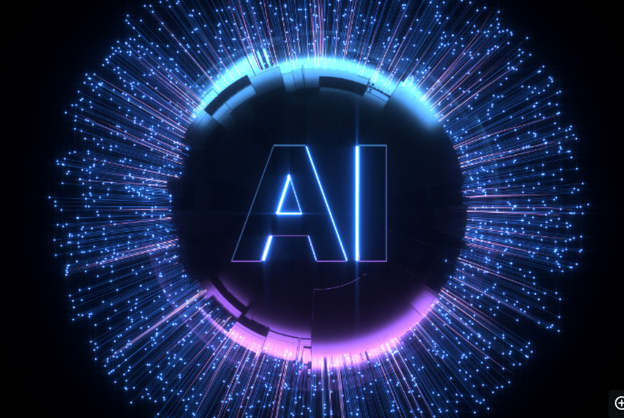Generative AI for Small to Midsized Organizations
As a leader, you’ve heard about generative AI, like ChatGPT and Claude for text generation and DALL-E for image generation.
However, you may need clarification on its full capabilities and how it can benefit your organization.
And how to separate hype from reality!
This quick guide aims to clarify the key aspects of this technology and provide insights into its abilities and limitations.
We aim to help you evaluate if and how generative AI could create strategic advantage – avoiding under and overestimating this technology’s abilities.
First, let’s look at exactly what is generative artificial intelligence.
What is Generative AI?
 Generative AI, at its core, is a subset of artificial intelligence that leverages machine learning techniques to generate data like the one it was trained on.
Generative AI, at its core, is a subset of artificial intelligence that leverages machine learning techniques to generate data like the one it was trained on.
In simple terms, it’s like an artist who learns by replicating the styles of masters before creating unique pieces of their own. This AI can create anything, from written text and images to music and complex designs, once learned from enough examples.
Unlike traditional AI models that provide fixed responses, generative AI takes it slightly higher. It generates new, often unique content or predictions based on learned patterns.
It’s like having a conversation with someone who doesn’t just respond to what you say but adds new ideas and perspectives. That’s the power of generative AI. It’s not just about understanding and replicating; it’s about creating and innovating.
Generative AI has the potential to revolutionize many sectors.
From creating realistic virtual assistants, designing new drugs, and simulating real scenarios for video games to generating unique articles or even art, its capabilities are as vast as they are impressive.
This transformative technology stands at the forefront of artificial intelligence’s future.
How Does Generative Artificial Intelligence (AI) Work?
Without delving too much into tech lingo, let’s understand how Generative AI comes to master this art of creation. The magic term here is ‘deep learning.‘
Deep learning is a subset of AI inspired by the structure of the human brain—we call these artificial neural networks.
These networks are fed vast amounts of data and learn patterns and relationships. The more data it processes, the more refined its understanding becomes.
Model Training: An Illustration
Imagine a Generative AI model being trained to compose music. We feed it countless musical pieces spanning various genres and styles. Over time, the model starts recognizing patterns—it learns the rhythm, the flow, and the coordination between different instruments.
It then leverages this learning to create original music compositions.
While complex, the world of Generative AI is a realm of infinite possibilities. As leaders in your organizations, understanding and harnessing this technology can be a significant stride toward innovation and growth.
Generative vs. Narrow AI
Unlike narrow AI, also called “weak AI,” which is focused on specific tasks, generative AI models can understand complex concepts and generate content around topics with few explicit rules.
This makes generative Artificial Intelligence more flexible, creative, and closer to general human intelligence than narrow AI.
Applications of Generative AI
Some leading examples of generative AI include:
- CHatGPT-4 for generating human-like text.
- DALL-E for creating images from text prompts.
- GitHub Copilot for assisting software developers.
- Jasper for synthesizing audio in any voice
The applications of generative models are rapidly expanding across industries.
The Future Potential of Generative AI
Generative AI offers tremendous potential for automating creative work and content generation. As the models continue to improve, it is expected to transform how media, entertainment, design, code, and many forms of content are produced.
However, there are also important considerations around ethics, bias, and responsible implementation.
The Current Leaders in Generative AI

The landscape of Generative AI is populated with some powerful players, each making impressive strides in their areas of expertise.
Here are a few noteworthy examples.
ChatGPT: Taking Artificial Intelligence to the Next Level
The launch of ChatGPT in November 2022 is widely seen as a major milestone that has changed the game for Artificial Intelligence for a few key reasons:
- It showcases the impressive progress of large language models. ChatGPT demonstrates a new level of natural language processing capabilities, understanding context and nuance and generating highly coherent responses.
- The conversational interface is highly accessible. Rather than a static Q&A, ChatGPT allows anyone to have a flowing dialogue by prompting it with natural text.
- The use cases and content it can generate are remarkably versatile – from explaining concepts to summarizing articles, translating text, answering trivia questions, developing poetry, and more.
- It signals a shift from narrow AI focused on single tasks to more general intelligence. While still limited compared to human cognition, ChatGPT points to a future of AI systems with more broad and flexible intelligence.
- The viral hype and public fascination since launch shows the disruptive potential as these models continue to improve. ChatGPT exceeded 1 million users within days of launc
- Its limitations also sparked important conversations around responsible AI development. This includes biases in training data, fact-checking, citing sources, and potential misuse of generative models.
While AI has progressed for years, ChatGPT’s accessible format, human-like capabilities, and rapid adoption represent a watershed moment highlighting the accelerating pace of advancement in generative AI.
DALL-E: Unleashing the Artist Within
Another marvel from OpenAI, DALL-E, takes Generative AI to an artistic dimension. It creates never-before-seen images from textual descriptions. Imagine asking for a two-story pink skyscraper shaped like a shoe—and voilà! DALL-E brings your imaginative request to life.
Exploring Other Key Players

Numerous other models are making waves in the Generative AI scene. Claude, for instance, has shown proficiency in simulating human-like text, while Sonantic uses Generative AI to produce remarkably realistic human speech.
Anthropic is working to create large-scale AI models that are steerable, meaning you can guide their behavior to better align with human values.
Each of these models underscores the broad spectrum of capabilities that Generative AI brings. The potential applications are limited only by our imagination.
Understanding the capabilities of these models can offer valuable insights into how Generative AI might serve your organization. The ability to generate human-like text, create novel designs, or simulate human speech could become game-changers in various business scenarios.
Unlocking its Potential: Generative AI at Work
Generative AI isn’t just fascinating technology—it’s a tool with many practical applications.
While it takes thoughtful implementation, the use cases benefiting from it are rapidly expanding.
-
Automating and Augmenting Content Creation
One of the biggest opportunities is using it to assist with creating all forms of content. For example, marketing teams can use AI writing assistants to draft blog posts, social media captions, website copy, etc.
The AI helps generate initial drafts that human writers can refine and finalize, enabling greater output.
Creative teams can prompt generative models to design graphical assets like logos, images, and data visualizations. This provides abundant raw material for designers to curate then and polish.
Services like Sonantic even allow voice cloning and AI-generated audio production.
The key is combining the strengths of AI and human creativity for enhanced content development and production workflows. While humans provide direction, quality control, and refinement, generative AI supercharges ideation and first-draft creation.
-
Building Conversational Interfaces

Generative AI excels at natural language processing, making it a game changer for customer-facing chatbots and virtual assistants.
With training data tailored to your industry, AI-powered conversational agents can handle routine customer service queries, provide shopping recommendations, and deliver 24/7 self-service support.
And with personalization capabilities, your chatbot can feel more “human” by providing customized interactions and suggestions based on the user’s profile and past behavior. Generative AI makes it possible to scale empathetic conversations tailored to each customer.
-
Personalizing Content for Each User
With massive datasets and advanced models, generative AI enables content to be adapted and generated uniquely for everyone receiving it. From personalized landing pages, customized training modules, individualized product recommendations, and more – the possibilities are vast.
Capitalizing on generative AI’s flexibility unlocks new ways to tailor messaging and experiences based on user interests, history, and demographics.
-
Fueling Creativity: Art and Music Generation
Generative AI isn’t just about crunching numbers—it has a creative side too. Models like DALL-E can generate art, and there are similar models for music. These tools can aid designers and artists by producing creative drafts or ideas, sparking innovation in unimaginable ways.
Understanding how Generative AI can be put to work is key for leaders who leverage its capabilities for their organizations. The intersection of technology and business has never been more exciting, and Generative AI sits right at the heart of it.
Sectors Impacted by Generative AI
Generative AI is making waves across various sectors. Its ability to generate content, simulate conversations, and provide personalization has proven valuable in fields as diverse as marketing and healthcare.
Let’s explore the sectors most impacted by this revolutionary technology.
-
Marketing and Advertising
It is transforming how we connect with consumers in marketing and advertising. It can generate tailored ad copies, streamline email campaigns, and even predict future trends, increasing efficiency and effectiveness.
-
Journalism and Publishing
In journalism and publishing, Generative AI’s role is twofold. It not only assists in drafting articles but also aids in personalized content distribution, providing readers with the most relevant information.
-
Customer Service and Support
In customer service and support, it powers chatbots and virtual assistants to provide real-time responses. This technology enhances customer interactions, reducing response times and ensuring customer satisfaction.
-
Creative Industries
In the creative industries, Generative AI is an invaluable tool for art and music generation. It can create unique pieces of work or spark innovative ideas, allowing artists to push the boundaries of their creativity.
-
Software Engineering
In software engineering, Generative AI can automate aspects of coding and debugging, thereby speeding up development cycles and enhancing product quality.
-
Education
In the field of education, it has a significant role. It’s reshaping how we learn, from generating educational content to providing personalized learning experiences.
-
Healthcare
It assists in everything from disease prediction to personalizing patient care in healthcare. It’s poised to revolutionize diagnosis, treatment, and patient management, improving outcomes and efficiency.
Generative AI, with its broad reach, is poised to reshape numerous sectors. Leaders who can understand and harness its capabilities will have an undeniable edge in the digital age.
Responsible Implementation of Generative AI

While Generative Artificial Intelligence holds transformative potential, it’s crucial to implement it responsibly. There are challenges and limitations to consider, including accuracy, bias, and security.
Let’s dive deeper into these aspects and explore the importance of oversight and governance.
-
Addressing Challenges and Limitations
Generative AI, like all technologies, has its challenges. For instance, accuracy can be a concern—AI doesn’t always get it right.
Moreover, AI models can inadvertently learn and reproduce biases present in the training data. Security is another significant concern, with misuse of technology leading to potential risks like deep fakes.
-
The Importance of Oversight and Governance
Ensuring responsible use of Generative AI requires oversight and governance. This means setting guidelines on AI use, monitoring AI systems for bias or errors, and setting up redressal mechanisms when things go wrong.
Strong oversight helps maintain trust in AI systems and ensures they are used for the benefit of all.
-
Balancing AI and Human Strengths: A Hybrid Approach
Finally, a hybrid approach leveraging AI and human strengths is key. It is a powerful tool but only replaces human judgment, creativity, and empathy. Using AI to handle routine tasks while leaving complex decisions to humans can strike the right balance.
Implementing it responsibly is no easy task, but it’s vital for maximizing its benefits while minimizing potential harm.
As we step further into the AI era, leaders need to champion the ethical use of AI and navigate the challenges.
Getting Started with Generative AI in Your Organization
Exploring how it can strategically benefit your business takes careful planning and preparation:
- First, audit your content assets and workflows to identify high-value pilot opportunities. Look for use cases where AI-generated content could augment human productivity, like social media management, blog writing, or product catalog creation. Start small with tightly scoped pilots led by teams with relevant expertise.
- Conduct an assessment of the unique risks and challenges of generative AI for your industry. Develop mitigation strategies around security, content moderation, and addressing potential biases. Bring in legal counsel to align policies with regulations.
- Vet vendors and partners thoroughly, particularly regarding data practices, model ethics, and transparency. Look for providers with robust training processes and a track record of responsible AI development. Seek hands-on support to tailor models to your use cases and data.
By embracing generative AI with eyes wide open, leaders can capture the benefits of this revolutionary technology while proactively navigating the risks. Those taking the initiative today will be best positioned to reap the rewards in the future as generative AI continues rapidly advancing.
The Future Impact of Generative AI
In the next 1-5 years, expect generative AI to make extraordinary leaps forward. Models will become more accurate, fast, and capable of complex reasoning and personalization. Key milestones on the horizon include:
- Near human-level fluency in conversational AI.
- Hyper-realistic media generation with both images and video.
- Explainability – AI does not just produce but explain its output.
- Increased speed and scale for enterprise applications.
- Specialized industry-specific AI models.
Long-Term Potential to Transform Industries

Further out, generative AI has the potential to transform entire industries through previously unimaginable levels of automation and intelligence. Media creation, content production, customer service, transportation, logistics, and more could fundamentally shift.
While predicting long-term remains speculative, the acceleration of AI capabilities shows no signs of slowing down. The scale of datasets used for training is growing exponentially – enabling models to keep rapidly improving.
Importance of Proactive Planning
Faced with such disruptive technology, organizations must act quickly. Proactive strategic planning will be critical to leverage the opportunities while mitigating risks.
Leaders today have a window to get ahead of the curve – piloting generative AI in focused applications, training employees for hybrid roles, and implementing governance to ensure responsible practices.
Companies that wait years to dabble in it will finally find themselves left behind competitors moving decisively today.
Though cautious experimentation is wise, complete inaction is the greatest risk in the face of this profound technological change.
Conclusion: How to Thrive in the Age of Generative AI
This guide will give you a practical overview of the current state and future trajectory of generative AI.
While capabilities are rapidly evolving, key insights include:
- Generative models like DALL-E and GPT-3 showcase a paradigm shift from narrow AI towards more flexible intelligence.
- Use cases delivering proven value expand across content creation, customer service, personalization, and more.
- Responsible implementation requires a hybrid approach blending AI with human oversight for quality and ethics.
- In the next 5 years, expect exponential leaps in generative models’ fluency, speed, and reasoning.
- Proactive planning is crucial to leverage opportunities while mitigating risks from such a disruptive technology.
Generative AI is not just a trend. It’s a revolutionary tool transforming sectors from marketing to healthcare.
However, its adoption comes with challenges like accuracy, bias, and security. Despite these hurdles, responsible implementation, oversight, and a hybrid approach can greatly enhance your operations.
Final Thoughts
The transformation Generative AI brings is inevitable. The question is: Will your organization ride the wave or be left behind? Embracing new technologies is about more than staying ahead.
It’s about shaping the future of your industry.
Next Steps
If you would like to go deeper into Artificial Intelligence (AI), check out these articles:
The 6 Top AI Tools for Small to Midsized Organizations…and Local Governments
If you would like to discuss how to add AI tools to your organization or have questions or concerns about your IT, Cybersecurity, or anything related to your technology, click on the link below:





